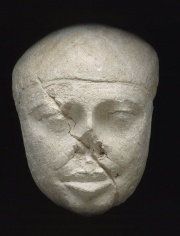Difference between revisions of "Gypsum plaster"
(username removed) |
(username removed) |
||
| Line 2: | Line 2: | ||
== Description == | == Description == | ||
| − | A type of plaster composed of [http://cameo.mfa.org/materials/fullrecord.asp?name=calcium | + | A type of plaster composed of [http://cameo.mfa.org/materials/fullrecord.asp?name=calcium%20sulfate%2C%20hemihydrate calcium sulfate hemihydrate]. Gypsum plaster has been used since antiquity. It is prepared by heating gypsum (calcium sulfate dihydrate) to partially remove the chemically bound water, thus producing calcium sulfate hemihydrate. When gypsum plaster is mixed with water, it converts to the hydrated calcium sulfate which rapidly sets to an impenetrable solid. It generates heat with setting and may expand slightly. Gypsum plaster is commonly called plaster of Paris. It is used for molds, sculptures and castings. See [http://cameo.mfa.org/materials/fullrecord.asp?name=plaster%20of%20Paris plaster of Paris] |
== Synonyms and Related Terms == | == Synonyms and Related Terms == | ||
| − | + | plâtre (Fr.); estuque (Port.); plaster; plaster of Paris; gypsum cement | |
== Additional Information == | == Additional Information == | ||
Revision as of 07:52, 24 July 2013
Description
A type of plaster composed of calcium sulfate hemihydrate. Gypsum plaster has been used since antiquity. It is prepared by heating gypsum (calcium sulfate dihydrate) to partially remove the chemically bound water, thus producing calcium sulfate hemihydrate. When gypsum plaster is mixed with water, it converts to the hydrated calcium sulfate which rapidly sets to an impenetrable solid. It generates heat with setting and may expand slightly. Gypsum plaster is commonly called plaster of Paris. It is used for molds, sculptures and castings. See plaster of Paris
Synonyms and Related Terms
plâtre (Fr.); estuque (Port.); plaster; plaster of Paris; gypsum cement
Additional Information
E.Sayre, "Deterioration and Restoration of Plaster, Concrete and Mortar" in Preservation and Conservation: Principles and Practice, S.Timmons (ed.), Preservation Press, Washington DC, 1976.
